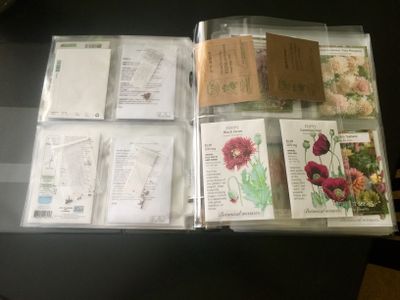Smart Seed Storage
Does a baggie full of seed packets in your crisper drawer sound familiar? Such seed storage may be fine, but it doesn’t allow easy viewing of varieties, dates, and planting times. Organizing and storing seeds is an important step for avid gardeners. There are many space-saving ways to organize seed, and it doesn’t have to be an expensive endeavor. Most seeds need to be saved in a dark, dry, and cool location. Seeds must be dry and stored in something that keeps moisture out. Silica packets or a posy of cat litter in the container can help leech moisture from the environment, but there is no substitute for a tightly fitting lid. That being said, many gardeners store seeds in envelopes or even plastic bags that don’t necessarily close tightly. Such methods are usually okay if you plan on using the seed within six months. Seed keeps best at temperatures below 40 degrees F. (4 C.). Often, a garage or basement will be cool enough for storage. In warm regions, the refrigerator is ideal. Once you have these conditions, it’s time to find the right space-saving ways to organize seeds that fit your lifestyle.
Organizing and Storing Seeds in Small Spaces
Keeping seed in an easy-to-use system that takes minimal space will take the headache out of storage. Glass jars are fine but take up room on a cool shelf. Much better options might include:
photo album or binder
pill organizer
shoe organizer
recipe box
DVD holder
jewelry or tackle box
tupperware
small file cabinet
The number of seeds and how you want to organize them will dictate what containers you use. A quick trip to the local dollar store will find many cheap and easy solutions for smart seed storage.
How to Organize Seed Packets
Once you have your container or file, you need to make seed packets easy to read and access. Placing labels on the outside of containers with seed type, harvest, and planting dates, will make finding varieties much easier. It also allows you to use the seed that is oldest first so it doesn’t go to waste. You might organize the seed by variety, which seed is planted indoors, and those that are direct sown. In a system with a clear pocket (a DVD holder or binder inserts, for instance), you can turn seed packets so the planting info and date are clearly shown. Each pocket can hold two seed packets, one on each side of the pocket, which makes it easy to view necessary info. A system in plastic bins might be organized by variety, clearly labeled on the outside, or any other classification that makes sense to you. There are no rules, but the idea is to preserve the seed, make it easy to manage, and prevent loss, all in a nice tidy space that doesn’t take up a lot of room.
